RESEARCH ON SUBURBAN RED-SHOULDERED HAWKS
1997 to 2014
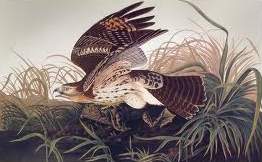
Since 1997, a team of ornithologists has been studying suburban
Red-shouldered Hawks in the Cincinnati area, in an effort to understand
the ecology of these interesting birds and the ways that they have
managed to survive despite increasing urbanization.
After quantifying habitat surrounding
suburban nests and comparing it to that surrounding nests in a rural
forested control area (the Hocking Hills region of south-central Ohio),
the researchers concluded that suburban hawks chose nests sites very
similar to those in the rural area in most ways
(See Journal Article). Nests were in large trees, situated among other
larger-than-average trees, and within 27-33 m of seasonal or permanent
streams, ponds, or other water. As expected, nests were closer houses
and roads in the Cincinnati area than they were in the rural Hocking
Hills region.
Red-shouldered Hawks in the
suburban area had reproductive rates that were similar to those from
rural Hocking Hills, averaging 1.7 young per active nest in suburban
southwest Ohio and 1.6 young per active nest in Hocking Hills
(See Journal Article). In the suburban
southwestern Ohio study area, some nest areas consistently fledged more
young than others. Some nest areas never fledged young, despite being
active for 5–6 years.
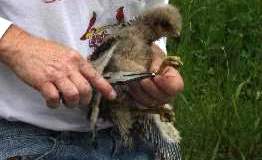 Researchers have banded over
2000
nestling Red-shouldered Hawks with an aluminum USGS bird band on one leg
and a plastic band (blue, black, green or yellow) on the other leg. The plastic
bands have letters and numbers that can be seen using binoculars or a
small scope. The purposes of banding are to individually identify hawks
for documentation of movements and mortality. Of 899 nestlings banded by
3 teams of banders in suburban southwestern from 1955-2002, 43 (4.8%)
were encountered (dead or alive) some time after fledging
(See Journal Article). Mean distance from natal nest at time of encounter was
38.5 + 13.6 km and was related to with hawk age. Analysis of distance
from natal nest at time of encounter indicated that 50% of suburban
hawks were found <15 km from where they were hatched, 75% were <29 km
away, and 95% were <62 km away. Average age of hawks found dead was 1.9
yr (N = 31). Analysis of age at recovery indicated that 50% of
Red-shouldered Hawks were dead by age 1.2 yr, 75% by 2.4 yr, and 95% by
5.2 yr,
although one hawk banded as an adult
in 1998 was still alive in spring 2014.
Most hawks died of unknown causes, but of those for whom the
cause of death was known, 38% died by collision with motor vehicles and
another 31% died of electrocution on utility wires or electric fences.
This information suggests that there may be an increased risk to living
in suburban area. In rare cases,
hawks nested on human-made structures. One pair nested successfully on
the rooftop of a 3-story apartment building for 4 years; another pair
nested on a grill located on the deck of a suburban home for 3 years,
but were not successful, and a third pair nested once on a rooftop of a
house. Researchers have banded over
2000
nestling Red-shouldered Hawks with an aluminum USGS bird band on one leg
and a plastic band (blue, black, green or yellow) on the other leg. The plastic
bands have letters and numbers that can be seen using binoculars or a
small scope. The purposes of banding are to individually identify hawks
for documentation of movements and mortality. Of 899 nestlings banded by
3 teams of banders in suburban southwestern from 1955-2002, 43 (4.8%)
were encountered (dead or alive) some time after fledging
(See Journal Article). Mean distance from natal nest at time of encounter was
38.5 + 13.6 km and was related to with hawk age. Analysis of distance
from natal nest at time of encounter indicated that 50% of suburban
hawks were found <15 km from where they were hatched, 75% were <29 km
away, and 95% were <62 km away. Average age of hawks found dead was 1.9
yr (N = 31). Analysis of age at recovery indicated that 50% of
Red-shouldered Hawks were dead by age 1.2 yr, 75% by 2.4 yr, and 95% by
5.2 yr,
although one hawk banded as an adult
in 1998 was still alive in spring 2014.
Most hawks died of unknown causes, but of those for whom the
cause of death was known, 38% died by collision with motor vehicles and
another 31% died of electrocution on utility wires or electric fences.
This information suggests that there may be an increased risk to living
in suburban area. In rare cases,
hawks nested on human-made structures. One pair nested successfully on
the rooftop of a 3-story apartment building for 4 years; another pair
nested on a grill located on the deck of a suburban home for 3 years,
but were not successful, and a third pair nested once on a rooftop of a
house.
The abundance of
Red-shouldered Hawks in study sites along streams in southern Ohio was
negatively correlated to the abundance of Red-tailed Hawks there
(See
Journal Article), which was expected since breeding hawks of both
species are highly territorial and will defend their territories from
intruders of any species. The abundance of hawks along the streams was
positively related to the number of small ponds within the stream
corridor; this finding was consistent with other studies in the eastern
U.S., many of which have shown an affinity of Red-shouldered Hawks for
ponds, wet woods, wetlands, and riparian areas.
The researchers
used radio-telemetry to measure the home ranges used by 11
Red-shouldered Hawks in suburban southwestern Ohio (See Journal
Article). On average, the hawks used 90 ha (222 acres) during the
breeding season and 165 ha (408 acres) annually. The average breeding
home range contained 169 houses. The typical annual hawk home range was
made up of 40.9% forested habitat, 50% suburban areas, 8.8% fields and
pastures, and 0.3% wet areas.
The suburban hawks spent more time in wet areas (along rivers, streams,
and ponds) than was expected, based on the availability of these
habitats within their home ranges, and they used suburban areas (houses,
roads, and lawns) less than expected. The hawks did use suburban areas
at times, hunting at bird feeders and ornamental ponds, and perching on
playground equipment and utility lines.
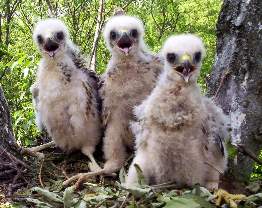 The research team observed 21
Red-shouldered Hawk nests for a total of 256 hours, in order to measure
food delivery rates to the nestlings, to identify prey types, and to
quantify adult and nestling behaviors
(See Journal Article). Small mammals made up the largest percentage of the
identified prey (31.5%), followed by reptiles (22.7%), invertebrates
(18.8%), amphibians (17.7%), birds (6.9%), and fish (2.5%). Season-long
prey delivery rate averaged 3.4 prey items delivered per 4-hr
observation period, or 116 g biomass delivered per 4-hr observation
period. As the nestling aged, the parent birds spent less time brooding
them, feeding them, and attending the nest. During the first two weeks
of the nestlings’ lives, at least one adult was present in the nest
about 70% of the day; nestlings <2 weeks old cannot maintain their own
body temperature or feed themselves. The research team observed 21
Red-shouldered Hawk nests for a total of 256 hours, in order to measure
food delivery rates to the nestlings, to identify prey types, and to
quantify adult and nestling behaviors
(See Journal Article). Small mammals made up the largest percentage of the
identified prey (31.5%), followed by reptiles (22.7%), invertebrates
(18.8%), amphibians (17.7%), birds (6.9%), and fish (2.5%). Season-long
prey delivery rate averaged 3.4 prey items delivered per 4-hr
observation period, or 116 g biomass delivered per 4-hr observation
period. As the nestling aged, the parent birds spent less time brooding
them, feeding them, and attending the nest. During the first two weeks
of the nestlings’ lives, at least one adult was present in the nest
about 70% of the day; nestlings <2 weeks old cannot maintain their own
body temperature or feed themselves.
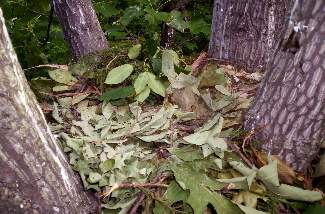 Red-shouldered Hawks typically line
their nests with fresh branches of coniferous and deciduous trees.
Researchers recorded all species of green vegetation
present in 63 nests in southwestern Ohio and 35 nests in rural Hocking
Hills. For comparison, they identified all trees in areas near nests in
southwestern Ohio and Hocking Hills. Red-shouldered Hawks at both sites
used branches from black cherry trees very often; more than 80% of nests
at both sites contained black cherry branches as nest lining
(See Journal Article). This was unexpected since black cherry trees made up
only 4- 5% of the total trees in the areas near the nests. Other tree
species selected by the Red-shouldered Hawks included white pine, red
pine, eastern hemlock, and red cedar. It is not known why hawks selected
these species, but black cherry is cyanogenic (the leaves produce
hydrogen cyanide when crushed), and it is possible that it functions as
a natural pesticide or pest repellent. Red-shouldered Hawks typically line
their nests with fresh branches of coniferous and deciduous trees.
Researchers recorded all species of green vegetation
present in 63 nests in southwestern Ohio and 35 nests in rural Hocking
Hills. For comparison, they identified all trees in areas near nests in
southwestern Ohio and Hocking Hills. Red-shouldered Hawks at both sites
used branches from black cherry trees very often; more than 80% of nests
at both sites contained black cherry branches as nest lining
(See Journal Article). This was unexpected since black cherry trees made up
only 4- 5% of the total trees in the areas near the nests. Other tree
species selected by the Red-shouldered Hawks included white pine, red
pine, eastern hemlock, and red cedar. It is not known why hawks selected
these species, but black cherry is cyanogenic (the leaves produce
hydrogen cyanide when crushed), and it is possible that it functions as
a natural pesticide or pest repellent.
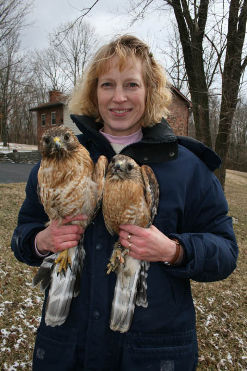 Like
most raptors, Red-shouldered Hawks have reversed sexual size dimorphism,
that is, the females are larger than the males. Differences in
size can be used to distinguish the sexes in some species. Multiple body
measurements were made on adult and nestling Red-shouldered Hawks. Adult
males could be distinguished from the females by body mass alone (birds
weighing less than 623.5 g were males). For nestlings older than 3
weeks, the length of the footpad and the body mass could be used to
differentiate males from females
(See Journal Article).
Being able to sex
adults and nestlings allows researchers to better understand sex-based
differences in dispersal, survival, and behavior. Like
most raptors, Red-shouldered Hawks have reversed sexual size dimorphism,
that is, the females are larger than the males. Differences in
size can be used to distinguish the sexes in some species. Multiple body
measurements were made on adult and nestling Red-shouldered Hawks. Adult
males could be distinguished from the females by body mass alone (birds
weighing less than 623.5 g were males). For nestlings older than 3
weeks, the length of the footpad and the body mass could be used to
differentiate males from females
(See Journal Article).
Being able to sex
adults and nestlings allows researchers to better understand sex-based
differences in dispersal, survival, and behavior.
Body measurements can also
be used to estimate age of nestling raptors. Researchers measured
multiple body parameters of known-age Red-shouldered Hawks in Cincinnati
and compared them to those of nestlings in Quebec. The length of
the secondary feathers on the nestlings' wings was the most valuable
parameter for estimating nestling age. Ohio nestlings differed
only slightly from Quebec nestlings, with the Ohio nestlings have
smaller secondaries relative to age.
While banding nestlings, researchers observed that some were infested
with larvae of bird blow flies in their ears in some locations.
Systematic study showed that 15 of 25 Hocking Hills nests had
Protocalliphora avium larvae on one or more nestlings and/or pupae
in the nest material. In contrast, no nestlings were parasitized
in the southwest Ohio (suburban Cincinnati) area. Reproductive
rates at parasitized and non-parasitized areas were similar, so it is
likely that Protocalliphora avium infestations did not have a
negative effect on fledging rates of young Red-shouldered Hawks
(See
Journal Article).
Suburban Red-shouldered
Hawk nests were occasionally usurped by Barred Owls, which nest
approximately 2 weeks earlier than Red-shouldered Hawks. Barred
Owls have been considered as the nocturnal equivalent to Red-shouldered
Hawks, but little was known about the habitat and ecology of suburban
Barred Owls. Researchers located 21 nests of Barred Owls and
compared nesting habitat to that of Red-shouldered Hawks. The primary
habitat type surrounding nests of both species was forest (41% for
Barred Owl nests and 46% for Red-shouldered Hawk nests), and the
second-most common was low-intensity residential land (30% for Barred
Owls and 29% for Red-shouldered Hawks). Pasture made up <15% for
both species. No variables discriminated habitat surrounding nests
of owls from those of hawks, suggesting that the two species use similar
suburban habitat in southwest Ohio
(See Journal
Article).
|

 Researchers have banded over
2000
nestling Red-shouldered Hawks with an aluminum USGS bird band on one leg
and a plastic band (blue, black, green or yellow) on the other leg. The plastic
bands have letters and numbers that can be seen using binoculars or a
small scope. The purposes of banding are to individually identify hawks
for documentation of movements and mortality. Of 899 nestlings banded by
3 teams of banders in suburban southwestern from 1955-2002, 43 (4.8%)
were encountered (dead or alive) some time after fledging
Researchers have banded over
2000
nestling Red-shouldered Hawks with an aluminum USGS bird band on one leg
and a plastic band (blue, black, green or yellow) on the other leg. The plastic
bands have letters and numbers that can be seen using binoculars or a
small scope. The purposes of banding are to individually identify hawks
for documentation of movements and mortality. Of 899 nestlings banded by
3 teams of banders in suburban southwestern from 1955-2002, 43 (4.8%)
were encountered (dead or alive) some time after fledging
 The research team observed 21
Red-shouldered Hawk nests for a total of 256 hours, in order to measure
food delivery rates to the nestlings, to identify prey types, and to
quantify adult and nestling behaviors
The research team observed 21
Red-shouldered Hawk nests for a total of 256 hours, in order to measure
food delivery rates to the nestlings, to identify prey types, and to
quantify adult and nestling behaviors
 Red-shouldered Hawks typically line
their nests with fresh branches of coniferous and deciduous trees.
Researchers recorded all species of green vegetation
present in 63 nests in southwestern Ohio and 35 nests in rural Hocking
Hills. For comparison, they identified all trees in areas near nests in
southwestern Ohio and Hocking Hills. Red-shouldered Hawks at both sites
used branches from black cherry trees very often; more than 80% of nests
at both sites contained black cherry branches as nest lining
Red-shouldered Hawks typically line
their nests with fresh branches of coniferous and deciduous trees.
Researchers recorded all species of green vegetation
present in 63 nests in southwestern Ohio and 35 nests in rural Hocking
Hills. For comparison, they identified all trees in areas near nests in
southwestern Ohio and Hocking Hills. Red-shouldered Hawks at both sites
used branches from black cherry trees very often; more than 80% of nests
at both sites contained black cherry branches as nest lining Like
most raptors, Red-shouldered Hawks have reversed sexual size dimorphism,
that is, the females are larger than the males. Differences in
size can be used to distinguish the sexes in some species. Multiple body
measurements were made on adult and nestling Red-shouldered Hawks. Adult
males could be distinguished from the females by body mass alone (birds
weighing less than 623.5 g were males). For nestlings older than 3
weeks, the length of the footpad and the body mass could be used to
differentiate males from females
Like
most raptors, Red-shouldered Hawks have reversed sexual size dimorphism,
that is, the females are larger than the males. Differences in
size can be used to distinguish the sexes in some species. Multiple body
measurements were made on adult and nestling Red-shouldered Hawks. Adult
males could be distinguished from the females by body mass alone (birds
weighing less than 623.5 g were males). For nestlings older than 3
weeks, the length of the footpad and the body mass could be used to
differentiate males from females